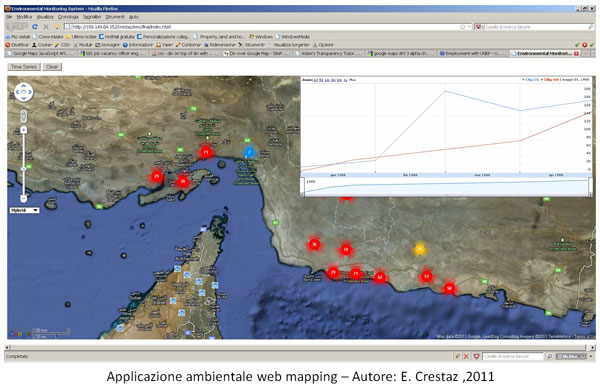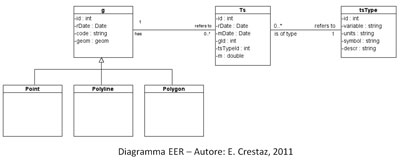Design and development of Web mapping applications
A course on theory and practice in GeoWeb 2.0 mashups design and development, integrating Google Maps and OpenLayer web services and spatio-temporal PostgreSQL/PostGIS database
![]() Brochure (not
available)
Brochure (not
available) ![]() MRegistration module
(not available)
MRegistration module
(not available)
The emergence of GeoWeb 2.0 promoted a totally new user experience in accessing geographic information, pointing at a strong integration of data sources and geographical services.
Traditional technologies, as CSS, HTML, XML and PHP, stay at the core of this revolution, further to new programming paradigms, geographical standards and innovative approaches to spatio-temporal data management, mashups development using web services as Google Maps and OpenLayers, as well as publication of new web services.

The course provides guidance towards design and development of web mapping applications, based on a review of key concepts in web services, distributed architectures, new Asyncronous (AJAX – Asyncronous JavaScript and XML) programming paradigm, geographical APIs, distributed databases, protocols and standards (WMS, and WFS; OGC, Open Geospatial Consortium) for deploying and implement geographical web services. The course will then focus on fundamentals in web programming and integration with web services and spatial databases, addressing both client and server sides, as HTML, CSS, Javascript, PHP, SQL and its spatial extensions.
Different Open Source and free software platforms and APIs will be used during the course, as PostgreSQL/PostGIS, QuantumGIS, Geoserver, Google Maps and Open Layers. At the same time issues of integration of proprietary ESRI ArcGIS platform in the mainstream of an Open Source technological stack will be investigrated, including the potentials in consuming web services and integrating spatio-temporal databases (direct connect, query layers in last release of ArcGIS 10).
Program
The course, adopting a theoretical/practical approach, will cover the following topics:
- Participants and course objectives presentation. Brief review of Web 2.0: business model shift and major technological advancements. Web services in Web 2.0: definitions, examples and relevant developments in GIS domain.
- Introduction to HTLM language: tags and document object model. Web page structure. CSS (Cascading Style Sheet). Example of creation of a simple web page.
- Introduction to XML (eXtensible Markup Language) technology, its impact on interoperability in the framework of GeoWeb 2.0 and specialization in geographical domain (GML, KML). Practicals on data files creation in XML and related XML schemas, focused on interoperability and validation.
- Web services. Further analysis of their architecture and objectives. WMS (Web Mapping Service), WFS and WFS-T (Web Feature Service e Transactional), from the perspective of OGC (Open Geospatial Consortium) standards. Introduction to geographical servers for publication of web services.
- Installation of Geoserver and QuantumGIS. Practicals on publication and use of geographical web services, based on vector and raster data. WMS services in ArcGIS.
- HTML and AJAX (Asynchronous Javascript And XML). Web services (REST and SOAP) and APIs. Standard OGC (Open Geospatial Consortium). Examples of web services (WMS, WFS).
- • Web mapping services: theory, APIs of Google Maps, Openstreetmap and Open Layers. Architecture of elementary web mashups, integrating Google Maps and Open Layers services, review of major APIs classes and integration of external data sources (text, csv, KML, WMS, Fusion, Google documents).
- Spatio-temporal databases for the web. Brief review of relational database model, Object relational developments, introduction to theory and technology inspatial database and their relevance in a distributed environment, for concurrent multi-user geographic information access. Introduction to PostgreSQL/PostGIS foundation concepts. Server-side technologies and PHP languages. Examples of PHP pages. Exercises based on elementary database schemas, direct connection through ArcGIS (Query Layers) and QuantumGIS, and data serving on the web through Geoserver.
- Design and development of a complete mashup web mapping application integrated with a spatio-temporal database.
- Portfolio of complex applications and future development trends. Conclusions.
GIScience project
The course is part of a wider learning project in GIScience and GIS, applications and geographic mashup development, environmental applications. Supported by high-level professional and academic profiles, the project includes following courses:

- Introduction to GIScience: principle and techniques for application development, visualisation and spatial analysis
- Design and development of GIS software applications: object oriented model, software engineering, Python programmingand its role in geoprocessing in ArcGIS
- Design and development ofWebmapping applications: a course on theory and practice in GeoWeb 2.0 mashups design and development, integrating Google Maps and OpenLayer web services and spatio-temporal PostgreSQL/PostGIS database
- Design and development of GIS software applications: software engineering, OO and components models, programming in VBA/ArcObjects for ArcGIS 8.x/9.
- Object Oriented JAVA programming for GIS applications development: a Open Source perspective to stand-alone and Web solutions
- A hands-on introduction to databases and geodatabases: A two-modules foundation course with examples in MySql, PostgreSQL/PostGIS, Oracle XE and ArcGIS/MsAccess for the design and development of Relational (I) and Spatial Databases (II)
- Business Geographics & Geodemographics
- Google Maps Mashups
- Environmental project management
- Applied groundwater flow and tran sport modeling: groundwater management at regional scale for water supply policies assessment and at local scale for environmental remediation of contamined sites
Following a complex and coherent learning path, after traditional part-time and distance learning philosophy, the course has been based, since its first edition in 2003, on both formal classes and self-learning periods, making course accessibility easier and learning objectives realistic

Software
PostgreSql/PostGIS, QuantumGIS, ESRI ArcGIS, Geoserver, Google Maps and OpenLayers APIs.

Who is it for?
The course is targeted to professional working in the public sector and young researchers that are interested in design and development in web mapping solutions.

Location & dates
The course will take place at the Environmental Education Centre Casa Archilei , located in Fano (PU) and easily accessible from major transport links. The course will have a duration of 40 hours, with 8 hours lesson on 14-15 June, 4-5-6 July 2013

Registration
Course fees are 1150 € + VAT ), to be paid in a unique instalment before starting date. Fees are reduced to 1050 € +21% VAT for participants with their own notebook. Further fees reduction is applicable, based on conditions stated below.
Registration before
May 30th, 2013 |
5% |
|---|---|
GIScience Alumni Students regularly enrolled in degree, post-degree and Phd courses at italian or foreign universities at the moment of registration Education Institutions, public and private companies enrolling more than one person |
10% |

Certificate
At the end of the course, participants attending at least 70% of the lessons will be awarded a Completion certificate.
Didactic material
References
- Obe R.O. and Hsu L.S., 2010. PostGIS in Action. Manning Publications Co. Unedited Draft, last update: 27/5/2010.
- Hazzard E., 2011. Open Layers 2.10: Create, optimize, and deploy stunning cross-browser web maps with the OpenLayers JavaSCript web mapping library: Beginner's Guide. Packt Publishing, Birmingham, UK
- Svennerberg G., 2010. Beginning Google Maps API 3. Apress, Berkeley, CA, USA

Info
For further information, please refer to info@giscience.it Email address or refer to contact references at Contacts section of web site www.giscience.it
.
